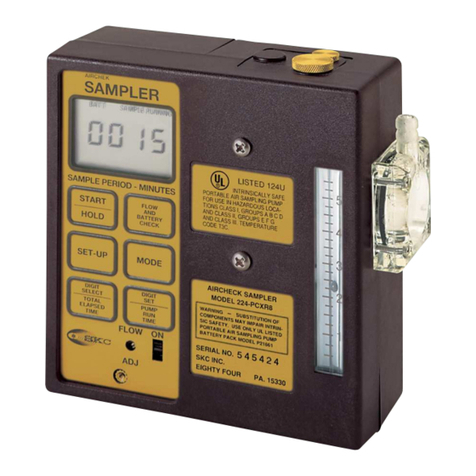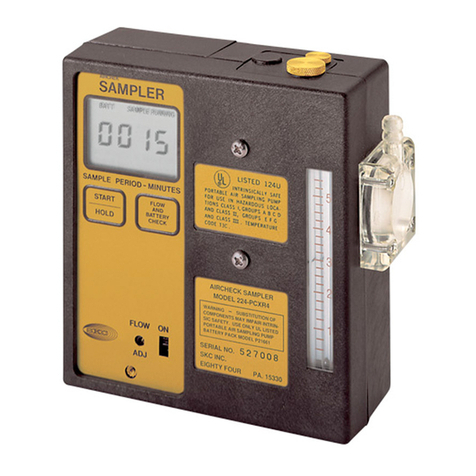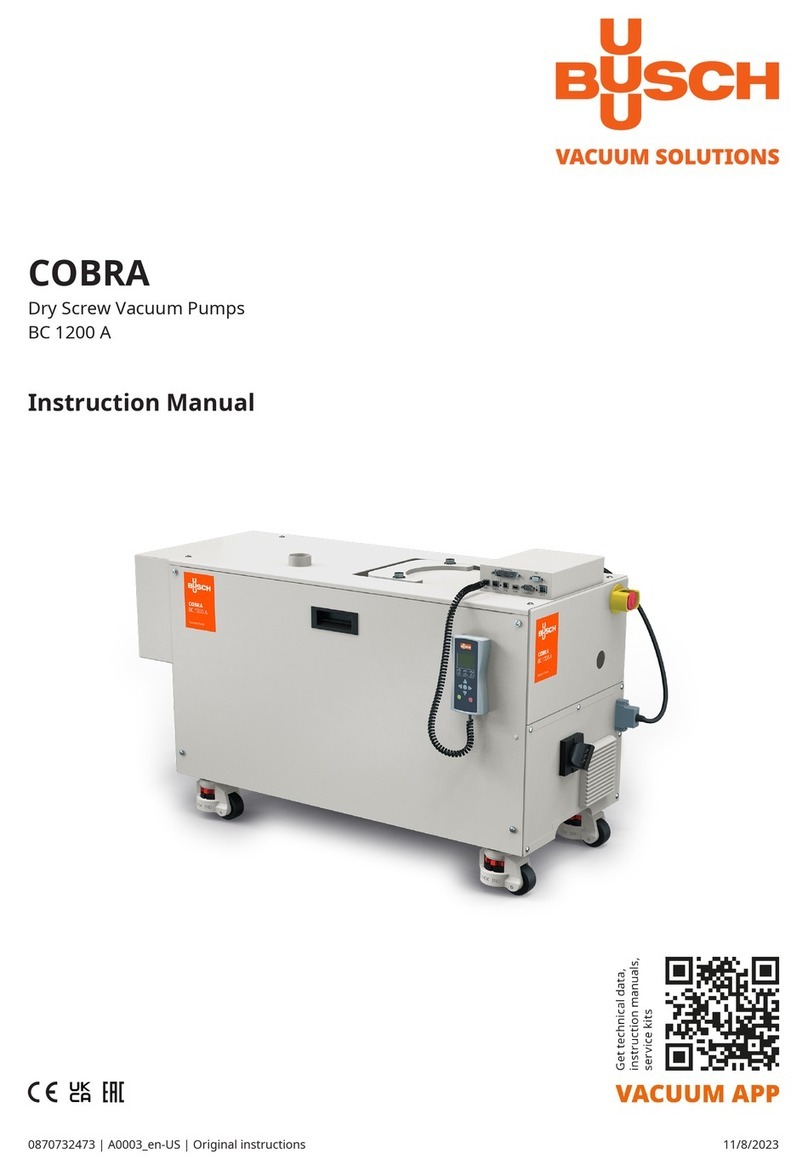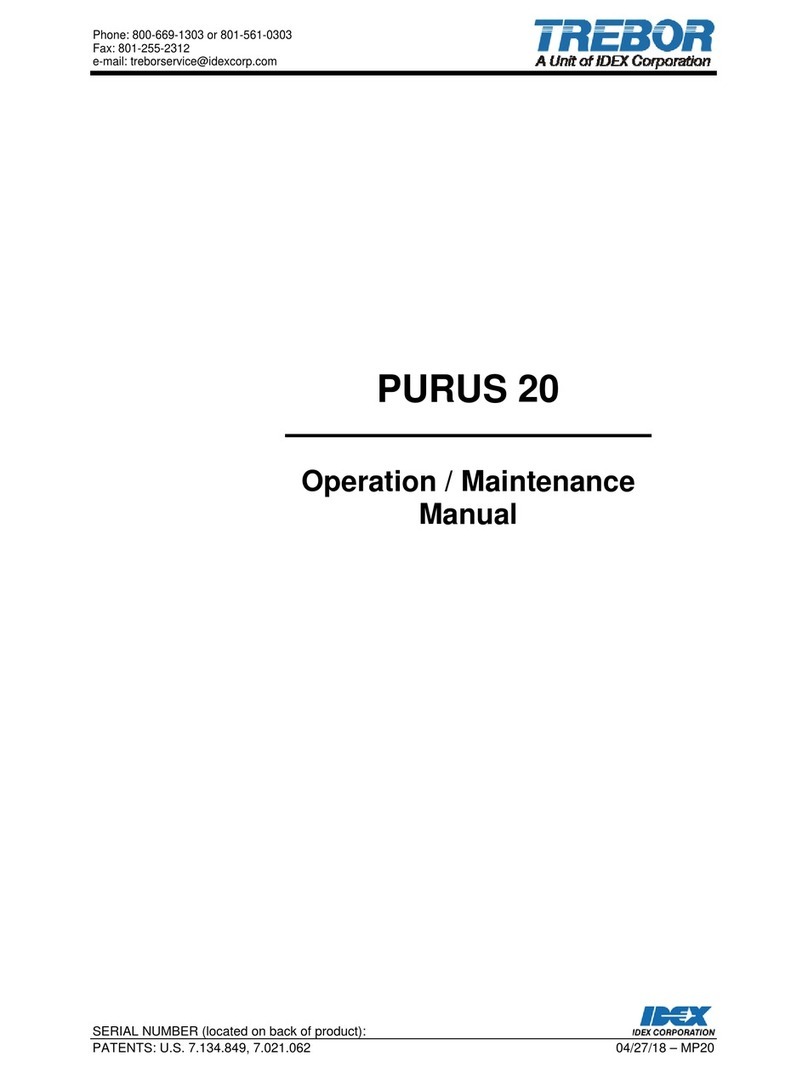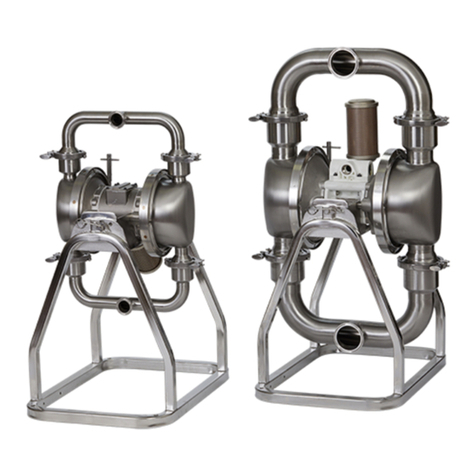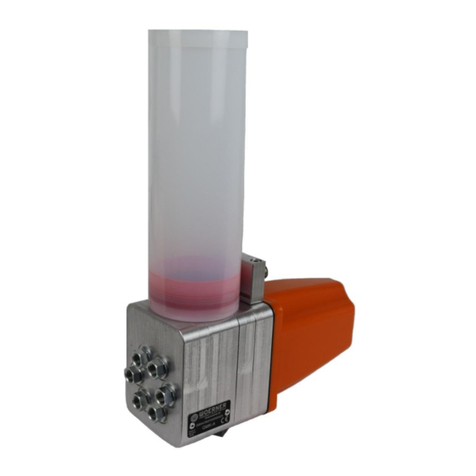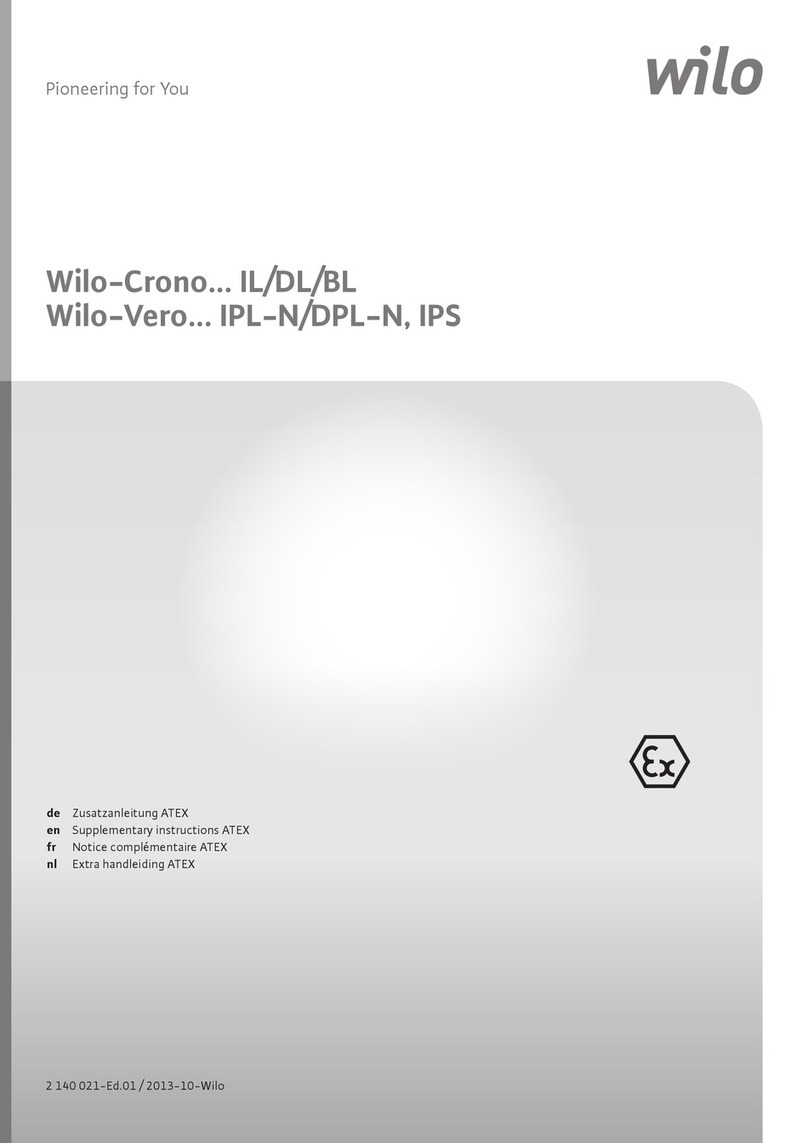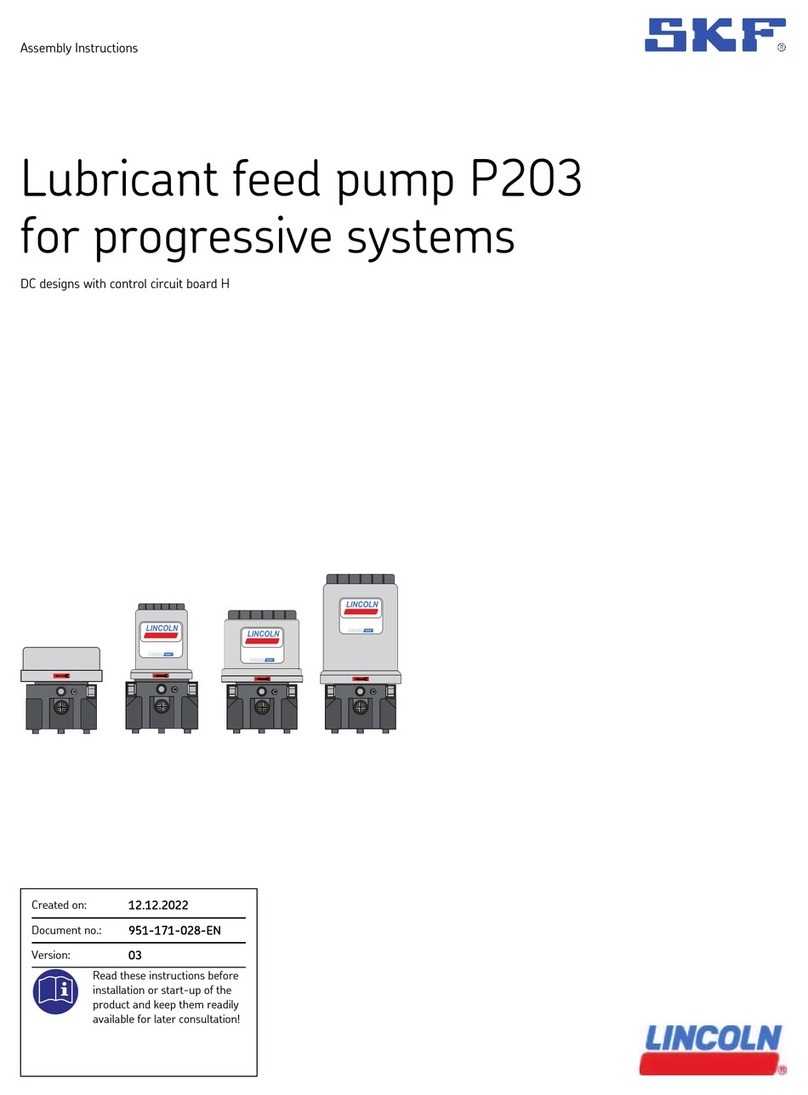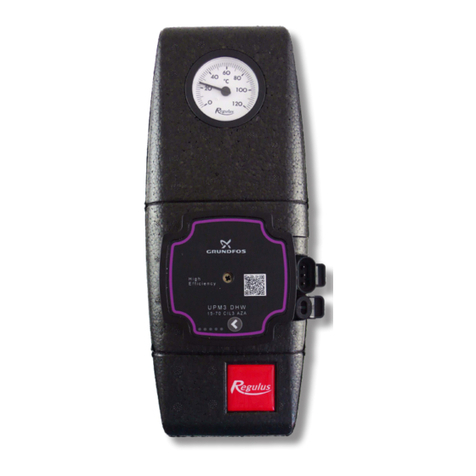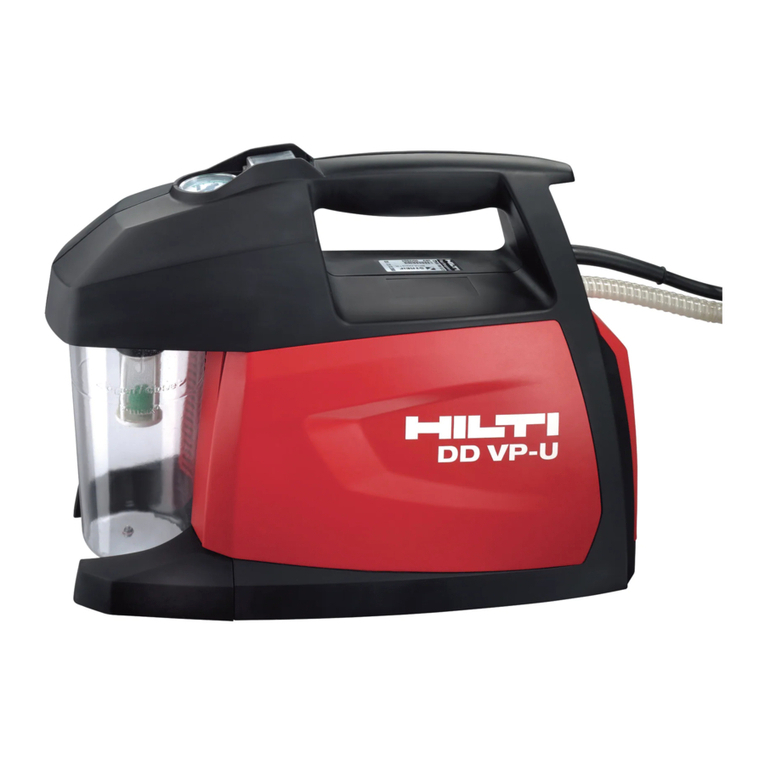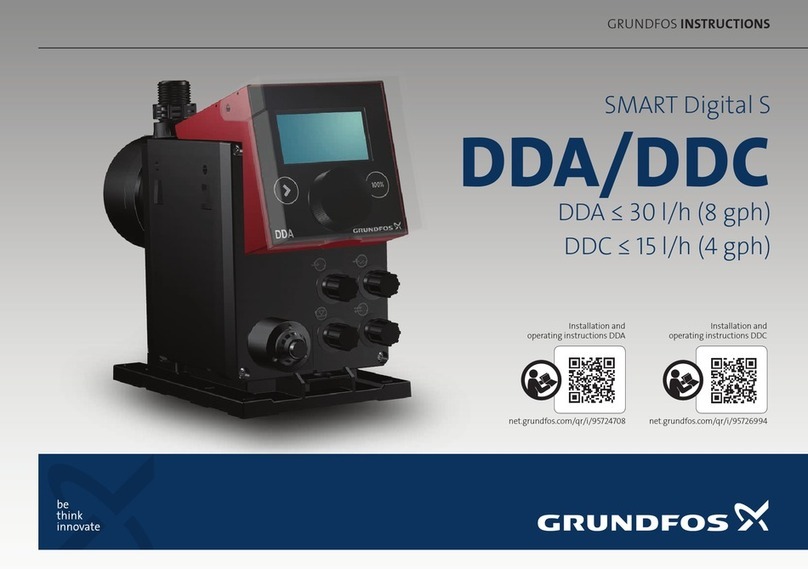SKC AirChek 52 User manual

Form 37714 Rev 1809
Page 1 of 13
www.skcinc.com
AirChek®52 Sample Pump
Cat. No. 224-52
Operating Instructions
863 Valley View Road, Eighty Four, PA 15330 USA • Tel: 724-941-9701 • www.skcinc.com
Top view
Protective control
cover (raised)
Pump inlet
(inlet filter underneath)
LCD
Flow
adjustment
screw
On/off button
Accessory
mounting screws
Battery pack
Front view Back view
Belt clip
Charging jack
Figure 1. AirChek 52 Sample Pump
Introduction
Description
The AirChek 52 Sample Pump (Figure 1) is designed for rugged industrial use at flows from 5 to 3000 ml/min. Ideal for on-worker
applications, use the AirChek 52 for short-term or full-shift sampling with sorbent tubes, impingers, size-selective samplers, or filter cassees.
Checking Pump/Kit Contents
Use the table below to verify that you received all items associated with the Cat. No. ordered. If you are missing items, contact
SKC at 800-752-8472 (U.S. only) or 724-941-9701.
If You Ordered Cat. No. Your Package Should Contain
224-52 AirChek 52 Sample Pump with NiMH battery pack and screwdriver set
224-52-S AirChek 52 Sample Pump with NiMH battery pack and screwdriver set, single PowerFlex charger with cable,
Tygon tubing (3 feet, 1/4-inch ID), and collar clip with cable tie
224-52K AirChek 52 Sample Pump with NiMH battery pack and screwdriver set, single PowerFlex charger with cable,
filter cassette holder, Tygon tubing (3 feet, 1/4-inch ID), and soft-sided nylon carry case
Required Equipment
;1/4-inch ID tubing
;PowerFlex®Charger
;Low flow accessories if sampling at 5 to 500 ml/min. See Accessories.

Form 37714 Rev 1809
Page 2 of 13
www.skcinc.com
Charging train with
single PowerFlex charger
Charging
jack
Power
cable
Charger
Charging
cable
Getting Started
Charge the Battery Pack
For optimum charge, ensure that the pump is not running.
1. Activate the charger (follow PowerFlex Operating Instructions 40069).
2. Insert the charging cable connector into the charging port on the charger.
See right.
3. Insert the charging plug end of the cable into the jack on the back of the
pump’s baery pack (Figure 1).
4. Charge the baery completely (the LED at the port connected to the pump
is a steady green) before using the pump.
5. Disconnect the charging cable from the back of the pump’s baery pack.
Notes and Cautions
• To comply with intrinsic safety regulations, do not charge or operate the pump from the charger in hazardous locations.
• Using a non-approved charger voids any warranty.
• Using a repaired or rebuilt battery pack voids any warranty and the UL Listing for intrinsic safety.
• Using any device other than the approved battery pack to power the pump voids the UL Listing for intrinsic safety and any warranty.
• Ensure proper orientation of charging cable before plugging it into the charging jack. Improper orientation/contact will short-circuit
the battery and voids any warranty.
• Short-circuiting the battery pack will render it immediately inoperative.
• Failure to follow warnings and cautions voids any warranty.
• The battery pack may be kept on the SKC-approved charger for an indefinite time.
For more information on SKC pump battery packs, visit www.skcinc.com/catalog/pdf/instructions/1756.pdf.
Use the Pump with AC Power (Power option in non-hazardous locations)
Do not use the pump with the Battery Eliminator in hazardous locations. UL Listing for intrinsic safety is not in effect during pump
operation with the Battery Eliminator.
The Baery Eliminator is an accessory that converts alternating current (AC) to direct current (DC) from which the pump can be operated
for extended runs. The Baery Eliminator should be used in non-hazardous locations only. See Accessories.
1. Remove the baery pack from the pump. See Replace the Baery Pack.
2. The Baery Eliminator is comprised of two pieces, a wall cube and a power adapter. Plug the wall cube into a standard wall outlet
and insert its plug end into the power adapter.
3. Fit the power adapter on the pump in place of the baery pack.

Form 37714 Rev 1809
Page 3 of 13
www.skcinc.com
Operation
High Flow Applications (1000 to 3000 ml/min)
Set/Calibrate Flow Rate
• Allow pump to equilibrate after moving it from one temperature extreme to another.
• Charge battery completely before calibration and sampling.
1. Ensure that the baery is fully charged and that the pump has run for five minutes before
calibrating. Leave the pump running.
2. Prepare the calibrator. See calibrator instructions.
3. Set up a calibration train: Using flexible tubing, connect the calibrator outlet (suction port)
to the representative sample medium inlet. Using ¼-inch Tygon tubing, connect the sample
medium outlet to the pump inlet. See right.
4. Using a screwdriver, set the pump flow rate by turning the flow adjustment screw on top of the pump (Figure 1), clockwise to increase
or counterclockwise to decrease flow, until the calibrator indicates the method-specified flow rate. Take a minimum of three readings
and record the average flow rate, as per OSHA/NIOSH instructions.
5. Press the on/offbuon to turn offthe pump. Disconnect the calibrator and flexible tubing from the representative sample medium
and proceed to Set Up/Sample.
Set Up/Sample
• Allow pump to equilibrate after moving it from one temperature extreme to another.
• Protect sample pump from weather when sampling outdoors.
• Powering the pump with any device other than the approved battery pack voids the UL Listing for intrinsic safety.
• Do not use the pump with the Battery Eliminator in hazardous locations. UL Listing for intrinsic safety is not in effect
during pump operation with Battery Eliminator.
• Use of any device other than the approved battery pack or Battery Eliminator to power the pump voids any warranty.
• Charge battery completely before calibration and sampling.
1. Replace the representative sample medium with new unexposed medium for sample collection.
2. Place the sample medium where appropriate for sampling.
a. For personal sampling, clip the sample collection medium to the worker in the breathing zone and the
pump to the worker’s belt using the belt clip.
When using an impinger, an in-line trap (SKC Cat. No. 225-22 or 225-22-01) is required between the pump and
impinger to prevent fumes from accidentally being drawn into the sampler. Failure to use an appropriate in-line
trap during impinger sampling voids any warranty.
b. For sampling with an impinger, mount the single or dual impinger and trap (SKC Cat. No. 225-20-01 or
225-20-02) to the face of the sampler using the accessory mounting screws (Figure 1) or place them in a
holster at the worker’s waist.
3. Press the on/offbuon to clear the elapsed time displayed on the LCD and to start sampling. Record the
start time and other pertinent information. The LCD will automatically display elapsed pump run time.
See below.
Possible Displays During Sampling
Flow or Baery Fault Shutdown - If the pump is unable to compensate due to excessive back pressure or a low baery
condition exists, it will shut down and timing functions will pause. The LCD will display either a baery-shaped icon
or a flow fault icon () depending on the cause of the shutdown. Upon flow fault, the pump will aempt to restart up
to five times. To restart from flow fault, correct the blockage and press the on/offbuon twice. The elapsed run time
display will reset to 0 when the pump is restarted. If the baery icon is displayed, recharge the baery before sampling.
Displayed Elapsed Run Time - Elapsed run time is displayed continuously on the LCD. For elapsed times after 999
minutes, the display still shows elapsed time but alternates between displaying the first two digits of the elapsed time
and the last three digits. For example, a pump that has run for 1,440 minutes would display first “01” and then “440.”
The display maximum is 99 999, which is 99,999 minutes.
4. At the end of the sampling period, press the on/offbuon and record stop time and other pertinent information.
chek-mate
Calibrator
Sample medium Tygon
tubing
Calibration train with filter cassette
Pump
inlet Suction
port
Clip sample medium
to worker and pump
to belt.
Impinger holder on pump
with impinger and trap

Form 37714 Rev 1809
Page 4 of 13
www.skcinc.com
High Flow Applications (Cont)
5. Cap the sample and send it with blanks and pertinent sampling information to a laboratory for analysis.
6. Verify the flow.
a. Turn on the pump and reinstate the calibration train and sample medium.
b. Take three readings and record the average value as the post-sample flow rate. Do not adjust the pump flow rate during this step.
c. Compare the pre and post-sample flow rates. Note in sampling documentation if the values differ by more than ± 5%.
Low Flow Applications (5 to 500 ml/min)
• Single-tube sampling requires the All-in-One Low Flow Holder; see the operating instructions for the All-in-One for details on its operation.
• Multiple-tube sampling requires a Constant Pressure Controller (CPC) and a Dual, Tri, or Quad Adjustable Low Flow Tube Holder accessory;
see the operating instructions for the CPC and Adjustable Low Flow Tube Holder for details on their operation.
Using the All-in-One Low Flow Holder (Figure 2)
Set/Calibrate Flow Rate for Single Tube
• Allow pump to equilibrate after moving it from one temperature extreme to another.
• Charge pump battery completely before calibration and sampling.
• Calibrate/verify pump flow rate before and after each sampling operation using the tube holder and
pump to be used for sampling.
• Set the flow rate through the pump first and then calibrate the flow rate through the representative
sorbent tube.
• Two small inlet holes on the bottom of the built-in CPC of the All-in-One can become blocked.
Periodically inspect and, if needed, clean with a small pick and blow particles away with a puff of air.
Pump Flow Rate
1. Ensure that the baery is fully charged and that the pump has run for 5 minutes before
calibrating. Leave the pump running.
2. Prepare the calibrator (see calibrator instructions). Using flexible tubing, connect the calibrator outlet (suction port) to the pump inlet.
3. Set the pump flow rate to 1.5 L/min. Using a small screwdriver, turn the flow adjustment screw on top of the pump (Figure 1), clockwise
to increase flow or counterclockwise to decrease flow, until the calibrator indicates 1.5 L/min.
4. Remove tubing from the pump inlet.
Flow Rate Through Sorbent Tube
1. Aach the Tygon tubing of the All-in-One to the pump inlet. Note: If the pump flow faults shortly after the holder is aached, check that
the needle valve is open by using a small flat-head screwdriver to turn the flow adjust screw on the holder slightly counterclockwise. If flow fault
continues, check that the two small holes on the boom of the built-in CPC are not blocked. If needed, clean them with a small pick and blow any
particles away with a puffof air.
2. Break tips offthe representative sorbent tube and insert it into the rubber sleeve on the All-in-One (arrow on the tube points toward
the holder). Note: Ensure that the sorbent tube fits snugly in the rubber sleeve prior to sampling to avoid air leakage. Two sleeves, each with a
different inner diameter, are supplied with the All-in-One.
3. Using flexible tubing, connect the calibrator outlet to the inlet of the representative sorbent tube in the holder. See calibration train above
right.
In the next step, do not shut off flow completely with flow adjust screw or use an oversize screwdriver to
adjust flow — valve or thread seat damage may result.
4. Do not adjust the flow on the pump. Adjust the flow rate through the representative sorbent tube
using a small flat-head screwdriver to turn the flow adjust screw on the All-in-One (counterclockwise
to increase, clockwise to decrease) until the calibrator displays the method-specified flow rate. Take a
minimum of three readings and record the average flow rate, as per OSHA/NIOSH instructions.
5. When calibration is complete, turn offthe pump by pressing the on/offbuon. Disconnect the calibrator
and tubing from the representative sorbent tube inlet.
Turn screw on holder
to adjust flow.
Flow
adjust
screw
Calibration train with All-in-One
Low Flow Holder connected
to AirChek 52
All-in-One
Tygon
tubing
Pump
inlet
Flow adjust screw
(needle valve)
Suction
port

Form 37714 Rev 1809
Page 5 of 13
www.skcinc.com
Clip tube holder to
worker and pump to belt.
Low Flow Applications (Cont)
Set Up/Sample with Single Tube
• Allow pump to equilibrate after moving it from one temperature extreme to another.
• Protect sample pump from weather when sampling outdoors.
• Use of any device other than the approved battery pack to power the pump voids the UL Listing for intrinsic safety and
any warranty.
• Charge pump completely before calibration and sampling.
• Calibrate/verify pump flow rate before and after each sampling operation using the tube holder and pump to be used for
sampling.
1. Replace the representative sorbent tube used for calibrating flow with a new unexposed sorbent tube for
sample collection. Note: Ensure sorbent tube fits snugly in rubber sleeve of the All-in-One before sampling to avoid
any air leakage. Two sleeves, each a different inner diameter (ID), are supplied.
2. Place the tube cover over the tube (Figure 2) and thread it into place on the All-in-One low flow holder.
3. Place the sorbent tube where appropriate for sampling. For personal sampling, clip the sample medium to
the worker in the breathing zone and the pump to the worker’s belt.
4. Press the on/offbuon to clear the elapsed time displayed on the LCD and to start sampling. Record the start time and other pertinent
information. The LCD will automatically display elapsed run time. See below.
Possible Displays During Sampling
Flow or Baery Fault Shutdown - If the pump is unable to compensate due to excessive back pressure or a low baery
condition exists, it will shut down and timing functions will pause. The LCD will display either a baery-shaped icon
or a flow fault icon () depending on the cause of the shutdown. Upon flow fault, the pump will aempt to restart up
to five times. To restart from flow fault, correct the blockage and press the on/offbuon twice. The elapsed run time
display will reset to 0 when the pump is restarted. If the baery icon is displayed, recharge the baery before sampling.
Displayed Elapsed Run Time - Elapsed run time is displayed continuously on the LCD. For elapsed times after
999 minutes, the display still shows elapsed time but alternates between displaying the first two digits of the elapsed
time and the last three digits. For example, a pump that has run for 1,440 minutes would display first “01” and then
“440.” The display maximum is 99 999, which is 99,999 minutes.
5. At the end of the sampling period, press the on/offbuon and record stop time and other pertinent information.
6. Cap the sample tube and send it with blanks and pertinent sampling information to a laboratory for analysis.
7. Verify the flow.
a. Turn on the pump and reinstate the calibration train and sample media.
b. Take three readings and record the average value as the post-sample flow rate. Do not adjust the pump flow rate during this step.
c. Compare the pre and post-sample flow rates. Note in sampling documentation if the values differ by more than ± 5%.
Figure 2. All-in-One Low Flow Holder Connected to AirChek 52
in One Low Flow Holder Conn
Flow adjust screw
(needle valve)
Threaded fitting All-in-One
rubber sleeve
Built-in CPC
Tygon tubing
Pump
inlet

Form 37714 Rev 1809
Page 6 of 13
www.skcinc.com
Low Flow Applications (Cont)
Using a CPC and Dual, Tri, or Quad Adjustable Low Flow Tube Holder (Figure 3)
Set/Calibrate Flow Rate for Multiple Tubes
• Requires Constant Pressure Controller (CPC) and Adjustable Low Flow Tube Holder (see Accessories). The low flow tube holder used with CPC
allows up to four tube samples to be taken simultaneously, each at different flow rates if desired.
• Allow pump to equilibrate after moving it from one temperature extreme to another.
• Charge pump battery completely before calibration and sampling.
• Calibrate/verify pump flow rate before and after each sampling operation using the tube holder and pump to be used for sampling.
• Set the flow rate through the pump first and then calibrate the flow rate through each representative sorbent tube.
Pump Flow Rate
Follow these important steps before proceeding.
1. Ensure that the baery is fully charged and that the pump has run for 5 minutes before calibrating. Leave pump running.
2. Prepare a calibrator (see calibrator instructions). Using flexible tubing, connect the calibrator outlet (suction port) to the pump inlet.
3. Calculate the sum of all tube flow rates. The maximum flow rate through any one tube is 500 ml/min.*
a. If the sum is ≤1000 ml/min, set the pump flow rate to 1.5 L/min.
b. If the sum is > 1000 ml/min, multiply that number by 0.15 and total the two numbers. Set the pump flow rate for the resulting
new sum. (Example: Sampling with three sorbent tubes, each with a flow rate of 500 ml/min.* The sum of the tube flow rates is
calculated as 3 x 500 = 1500. Determining a 15% higher flow rate is calculated as 1500 x 0.15 = 225. Calculating the final pump
flow seing would be 1500 + 225 = 1725 ml/min.)
* Back pressure across some sample tubes can be higher than average. In these instances, the maximum flow rate of 500 ml/min per tube may not
be achieved.
4. Using a small screwdriver, turn the flow adjustment screw on top of the pump (Figure 1) (clockwise to increase flow or counterclockwise
to decrease flow) until the calibrator indicates the required flow rate.
5. Remove tubing from the pump inlet and calibrator outlet.
Figure 3. Quad Adjustable Low Flow Tube Holder
Top view of flow
adjust screws
Anti-tamper cover
Low flow holder outlet
Sorbent sample tube
Rubber sleeve
Clothing clip
Flow adjust screws
Protective cover

Form 37714 Rev 1809
Page 7 of 13
www.skcinc.com
Flow Rate Through Sorbent Tubes
1. Aach the tubing on the CPC outlet (side of the CPC without a label) to the pump inlet. Aach
the Adjustable Low Flow Holder to the CPC inlet (marked “To Sample”). See Figure 4.
2. Break tips offthe representative sorbent tubes and insert the tubes into the rubber sleeves on
the holder (arrow on each tube pointing toward pump). Place unopened tubes in any unused
ports to “seal” them.
3. Label all representative tubes and ports.
4. Using flexible tubing, connect the exposed end of the first active tube to be calibrated to the
calibrator outlet (suction port).
5. Using a small screwdriver, loosen and turn the brass flow adjust screw (see above right)
directly beneath the port holding the first active tube to be calibrated (clockwise to increase,
counterclockwise to decrease) until the calibrator indicates the method-specified flow rate. Do
not adjust the flow rate on the pump. Note: For tri and quad models, first rotate each anti-tamper
cover to expose the flow adjust screws, then adjust the appropriate one until the calibrator indicates the
desired flow (Figures 3 and 5).
6. Repeat Steps 4 and 5 for each active representative tube. Note: Changing the flow on one tube will
not affect the flow rate through the remaining tubes.
7. Once flow is calibrated for each active tube, it is recommended practice to re-check the flow rate
through representative tubes before removing them. Any adjustment should be minimal.
Screw Screw
Figure 5. Cut-away of Tri/Quad
Adjustable Low Flow Tube Holder
Turn screw on
tube holder to
adjust flow.
Flow adjust screws
Connect
CPC to
pump inlet,
tube holder
to CPC, and
tube inlet to
calibrator.
Figure 4. Calibration Train with Quad Adjustable
Low Flow Tube Holder
Suction port
chek-mate Calibrator
Quad tube holder
Tube holder outlet
Pump
inlet
CPC inlet (marked
“To Sample”)

Form 37714 Rev 1809
Page 8 of 13
www.skcinc.com
Set Up/Sample with Multiple Tubes
• Requires Constant Pressure Controller (CPC) and Adjustable Low Flow Tube Holder (see Accessories). The low flow tube holder used with CPC
allows up to four tube samples to be taken simultaneously, each at different flow rates if desired.
• Allow pump to equilibrate after moving it from one temperature extreme to another.
• Protect sample pump from weather when sampling outdoors.
• Use of any device or battery pack other than P85004 or P84002 to power the pump voids the UL Listing for intrinsic safety.
• Charge pump completely before calibration and sampling.
• Calibrate/verify pump flow rate before and after each sampling operation using the tube holder and pump to be used for
sampling.
1. Replace the representative sorbent tubes used for calibration with new unexposed sorbent tubes for sample
collection.
2. Place a protective tube cover over each tube and thread into place on holder until secure.
3. Place the adjustable holder with tubes where appropriate for sampling. For personal sampling, clip the low
flow tube holder to the worker in the breathing zone and the pump to the worker’s belt.
4. Press the on/offbuon to clear the elapsed time displayed on the LCD and to start sampling. Record the start time
and other pertinent information. Sample for the time specified in the method used. The LCD will automatically
display elapsed run time.
Possible Displays During Sampling
Flow or Baery Fault Shutdown - If the pump is unable to compensate due to excessive back pressure or a low baery
condition exists, it will shut down and timing functions will pause. The LCD will display either a baery-shaped icon
or a flow fault icon () depending on the cause of the shutdown. Upon flow fault, the pump will aempt to restart up
to five times. To restart from flow fault, correct the blockage and press the on/offbuon twice. The elapsed run time
display will reset to 0 when the pump is restarted. If the baery icon is displayed, recharge the baery before sampling.
Displayed Elapsed Run Time - Elapsed run time is displayed continuously on the LCD. For elapsed times after 999
minutes, the display still shows elapsed time but alternates between displaying the first two digits of the elapsed time
and the last three digits. For example, a pump that has run for 1,440 minutes would display first “01” and then “440.”
The display maximum is 99 999, which is 99,999 minutes.
5. At the end of the sampling period, press the on/offbuon and record stop time.
6. Cap the sample tubes and send with blanks and pertinent sampling information to a laboratory for analysis.
7. Verify the flow.
a. Turn on the pump and reinstate the calibration train and sample media.
b. Take three readings and record the average value as the post-sample flow rate. Do not adjust the pump flow rate during this step.
c. Compare the pre and post-sample flow rates. Note in sampling documentation if the values differ by more than ± 5%.
Clip tube holder to
worker and pump
to belt.

Form 37714 Rev 1809
Page 9 of 13
www.skcinc.com
Battery pack
release arms
Battery pack
Security screws
in out position
Maintenance
Replace the Pump Inlet Filter
The AirChek 52 Sampler is fied with a filter/trap just below the pump inlet. This prevents particles from
being drawn into the pump mechanism. The filter should be replaced periodically as follows:
1. Grip the inlet fiing (see right) and turn it counterclockwise to unthread it.
2. Holding the pump upside down, use a small flat-head screwdriver or tweezers to remove the filter.
3. Place a new filter in the inlet. Ensure that the rubber gasket inside the inlet fiing is still in place.
4. Thread the inlet fiing back into place.
Replace the Battery Pack
Use of a repaired or rebuilt battery pack voids any warranty and the UL Listing for intrinsic safety.
1. Loosen two security screws on boom of pump case and allow them to fall to the out position.
2. Pinch baery pack release arms and pull the boom half of the pump case away from
the top half.
3. Align arms on top half of case with slots on either side of the new baery pack
housing. Ensure that the back of the baery pack with the charging jack is on the
same side as the belt clip.
4. Slide baery pack up until arms click into place.
5. Push each security screw into the baery pack housing and tighten.
Once installed, completely charge the new battery pack before operating the pump (see Charge the Battery Pack). It may be necessary to
charge it a few times before achieving maximum battery capacity.
For information on SKC pump baery packs, visit hp://www.skcinc.com/instructions/1756.pdf.
Pump Service
Pumps under warranty should be sent to SKC Inc. for servicing. See Limited Warranty and Return Policy.

Form 37714 Rev 1809
Page 10 of 13
www.skcinc.com
Accessories/Replacement Parts
Accessories Cat. No.
chek-mate Calibrator with CalChek, 0.50 to 5 L/min, includes 9-volt alkaline battery and
NIST-traceable certificate 375-0550N
Low Flow Sampling
Low Flow (5 to 500 ml/min) Kit includes All-in-One low flow holder and Type A tube cover 210-500
Adjustable Low Flow Tube Holders
Use with CPC listed below. Require separate tube covers listed below
Dual Holder 224-26-02
Tri Holder 224-26-03
Quad Holder 224-26-04
Constant Pressure Controller (CPC) 224-26-CPC
Protective Tube Covers for Sorbent Tubes
Use with adjustable low flow tube holders listed above.
Type A - 6-mm OD x 70-mm L, included in Low Flow Kit above 224-29A
Type B - 8-mm OD x 110-mm L 224-29B
Type C - 10-mm OD x 150-mm L 224-29C
Type D - 10-mm OD x 220-mm L 224-29D
Battery Maintenance
PowerFlex Charging System for SKC Personal Pumps
5-Station, 100-240 V 223-1000
Single, 100-240 V 223-2000
PowerFlex Pump Cable, for AirChek 52 223-1004
Battery Eliminator,* connects pump to line power for extended sampling, 115 V 223-300
Pump Operation
Screwdriver Set, included with pump 224-11
Protective Nylon Pouch with belt and shoulder strap
Black 224-88
High-profile Red 224-96A
Noise-reducing Black 224-96C
* Not UL Listed for intrinsic safety

Form 37714 Rev 1809
Page 11 of 13
www.skcinc.com
Replacement Parts
Use only SKC-approved parts to ensure reliable performance. Failure to do so voids the UL Listing
for intrinsic safety and any warranty.
Use of a repaired or rebuilt battery pack voids any warranty and the UL Listing for intrinsic safety.
Failure to follow warnings, cautions, and notes voids any warranty.
Internal Stack
No. Description Cat. No.
1A/1C Stack screws, pk/12 P51891
2Inlet/Hose Connect, includes filter and gasket P20106
2A Replacement Inlet Filter, pk/10 P40370
3Pulsation dampener P2010802
4Stack plate N/A
5A/5B Valve plates (top and bottom) P213201
6Diaphragm/Yoke assembly P2129B
7Pump body P22417G
8Motor/Eccentric P518803
9Pump base plate P20102
Full Stack without Motor P20102A
Parts not indicated in illustration:
N/A PC Board P79592
N/A Screw and O-ring Set (complete for one pump) P22402
External Case
No. Description Cat. No.
1Battery Pack, NiMH P78011AMH
2Battery Pack Release Arms N/A
3Battery Pack Security Screws N/A
4Compensation Pot A N/A
5Compensation Pot B N/A
6Power Plug for Battery Pack, pk/5 P20107
7Charging Jack (on rear of battery pack) N/A
8Impinger Holder Mounting Screws N/A
9Inlet (includes filter and gasket) P20106
10 Control Cover P20105
11 Flow Adjustment Screw N/A
12 Power Switch (on/off) N/A
13 Belt Clip (not shown) P20104
14 LCD P72391
15 External Case P2010003
SKC Limited Warranty and Return Policy
SKC products are subject to the SKC Limited Warranty and Return Policy, which provides SKC’s sole liability and the buyer’s exclusive
remedy. To view the complete SKC Limited Warranty and Return Policy, go to hp://www.skcinc.com/warranty.
1A
2A
8
9
2
3
4
7
5A
5B
6
1B
1C
7
AIRCHEK
®
52
10
3
9
14
12
8
2
1
2
4
5
6
11
Bottom of pump
without battery pack
3
15
13

Form 37714 Rev 1809
Page 12 of 13
www.skcinc.com
Appendix
Performance Profile
Flow Range 1000 to 3000 ml/min
5 to 500 ml/min requires low flow accessories. See Accessories.
Flow Control Holds constant flow to ± 5% of set-point after calibration
Compensation Range
(back pressure capability)
1000 ml/min up to 25 inches water back pressure
2000 ml/min up to 25 inches water back pressure
2500 ml/min up to 20 inches water back pressure
3000 ml/min up to 15 inches water back pressure
Typical Back Pressure of
Sampling Media
(inches water)
Flow Rate (L/min) 1.0 1.5 2.0 2.5
Filter/Pore Size (μm)
25-mm MCE/0.8 6 9 12 15
25-mm MCE/0.45 14 22 28 35
37-mm MCE/0.8 2 3 4 5
37-mm PVC/5.0 1 1 2 2
Compare the information in this table to pump compensation range to determine appropriate applications.
Run Time Nickel-metal hydride (NiMH) battery: 12 hrs minimum at 2000 ml/min and up to 25 inches
water back pressure; depends on media used. See Table 1.
Battery Eliminator: Pump provides extended runs.
Power Supply Rechargeable 4.8-V NiMH battery pack, 3.3-Ah capacity
A Battery Eliminator is available (see Accessories); use voids the UL Listing for intrinsic safety.
Battery Charging Time
(varies with battery capacity
and level of discharge)
6 to 8.5 hrs with PowerFlex charger
Temperature Operating: 32 to 104 F (0 to 40 C)
Storage: -4 to 113 F (-20 to 45 C)
Charging: 50 to 113 F (10 to 45 C)
Humidity 0 to 95% non-condensing
Flow Fault If the pump is unable to compensate for longer than 15 seconds due to excessive back pressure, the pump
enters flow fault. During flow fault, the pump stops, the fault icon appears on the display, and elapsed
time remains on the display. Auto-restart is attempted up to 5 times. Note: Elapsed time information
will be lost on restart.
Low Battery Fault LCD displays low battery icon and pump shuts down. LCD remains on.
Time Display LCD shows elapsed pump run time in minutes up to 99,999.
Note: Older pump models display elapsed time up to three digits (999) and then roll back to zero.
LCD Indicator LCD always remains on. Displayed elapsed run time information resets when pump is started.
Noise Level 62.5 dBA* - pump without case
55 dBA* - pump housed in noise-reducing case (optional accessory Cat. No. 224-96C, see Accessories)
* Measured 3 ft (1 m) from pump operating at 2 L/min with a 37-mm, 0.8-μm MCE filter cassee
RFI/EMI Shielding 27 to 1000 MHz
Intrinsic Safety UL Listed for Intrinsic Safety: Class I, Division 1 and 2, Groups A, B, C, D; Class II, Division 1 and 2,
Groups E, F, G; and, Class III, Temperature Code T3C. ATEX-approved models available. Contact SKC.
Dimensions 5 x 3 x 1.75 in (12.7 x 7.6 x 4.4 cm)
Weight 20 oz (567 grams)
Multiple-tube Sampling Requires additional accessories to sample with up to four sorbent tubes simultaneously at flows from
5 to 500 ml/min, dependent on back pressure. See Accessories.
Tubing Requires 1/4-inch ID tubing
Certifications • Intrinsic safety: UL Class I, Groups A, B, C, and D; Class II, Groups E, F, and G; Class III hazardous
locations when used with SKC battery pack model P78011AMH (SKC Cat. No. P78011AMH)
• CE marked
• ATEX-approved models available

Form 37714 Rev 1809
Page 13 of 13
www.skcinc.com
Mixed Cellulose (MCE) filter, 0.8-μm pore size
Flow Rate (L/min)
Filter Diameter
37 mm 25 mm
2.0 40 37
2.5 38 29
3.0 34 25
Polyvinyl Chloride (PVC) filter, 5.0-μm pore size
Flow Rate (L/min)
Filter Diameter
37 mm 25 mm
2.0 56 47
2.5 48 41
3.0 42 38
Table 1. Pump Run Time in Hours with NiMH Battery
Appendix (Cont)
Typical Run Times
Table 1 contains the typical run times achieved when using a fully charged NiMH baery pack. Data is sorted by type of sample media.
All run times are listed in hours. Results are obtained using a new pump and new fully charged baery. Pump performance may vary.
Increases in back pressure during sampling due to buildup of sample on the filter can decrease baery life.
Other manuals for AirChek 52
1
Table of contents
Other SKC Water Pump manuals

SKC
SKC AirChek2000 User manual
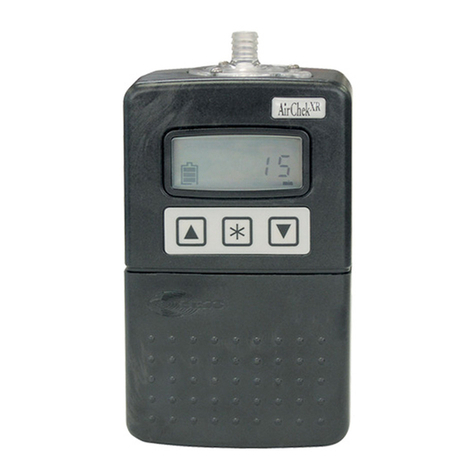
SKC
SKC AirChek XR5000 User manual
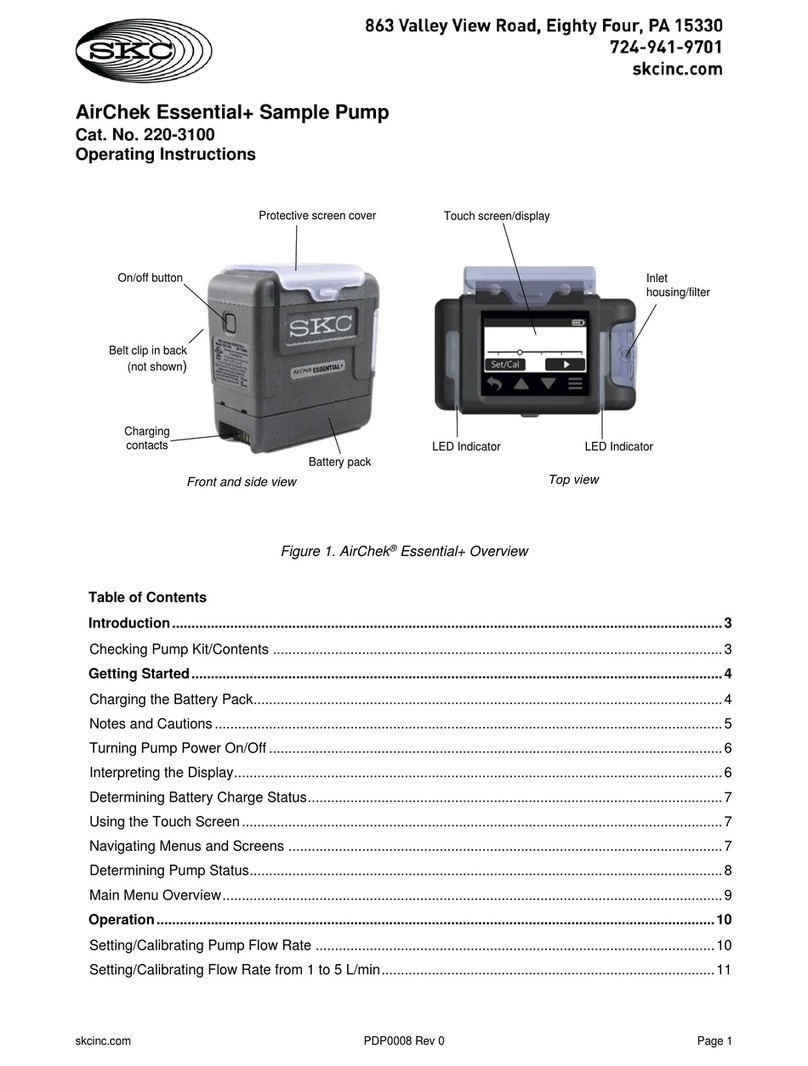
SKC
SKC AirChek 220-3100 User manual
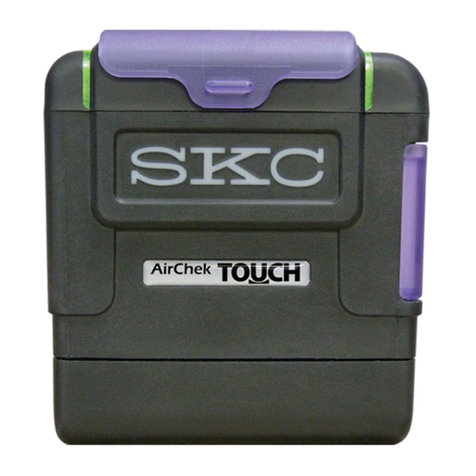
SKC
SKC AirChek TOUCH 220 Series User manual
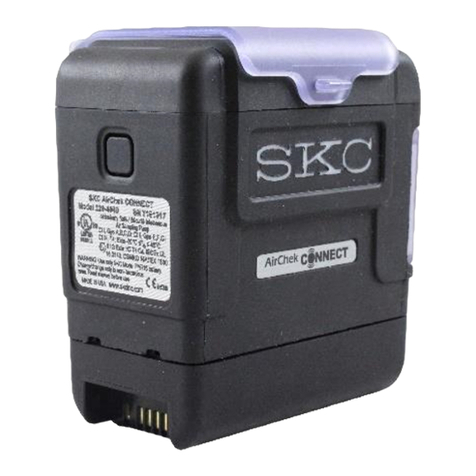
SKC
SKC AirChek Connect User manual
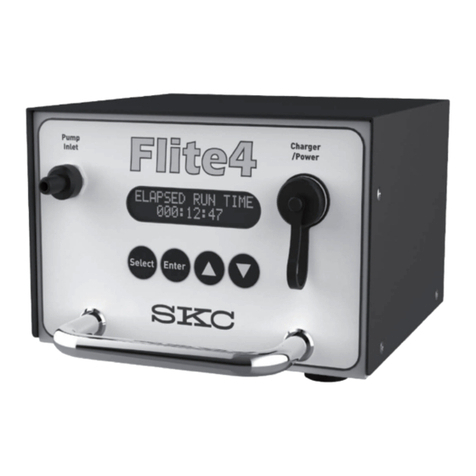
SKC
SKC Flite4 User manual
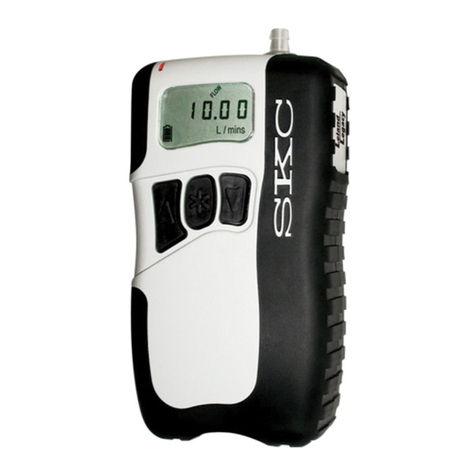
SKC
SKC Leland Legacy User manual
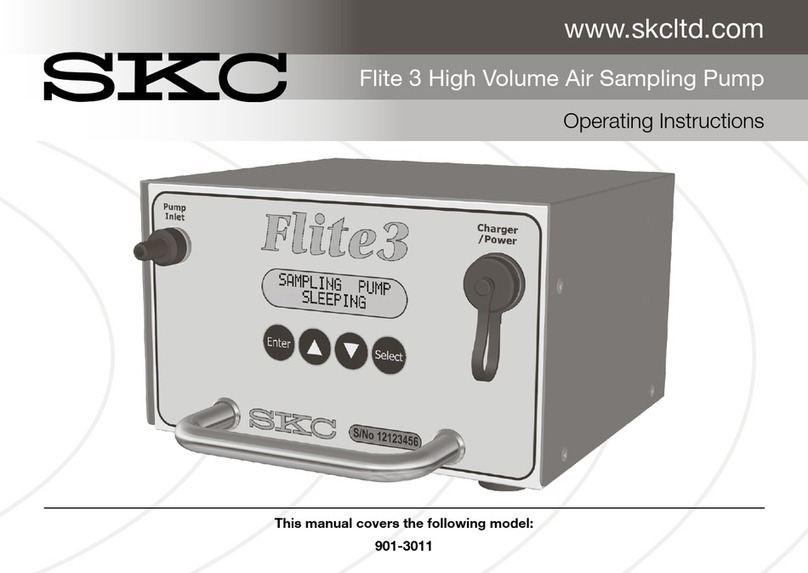
SKC
SKC Flite 3 User manual
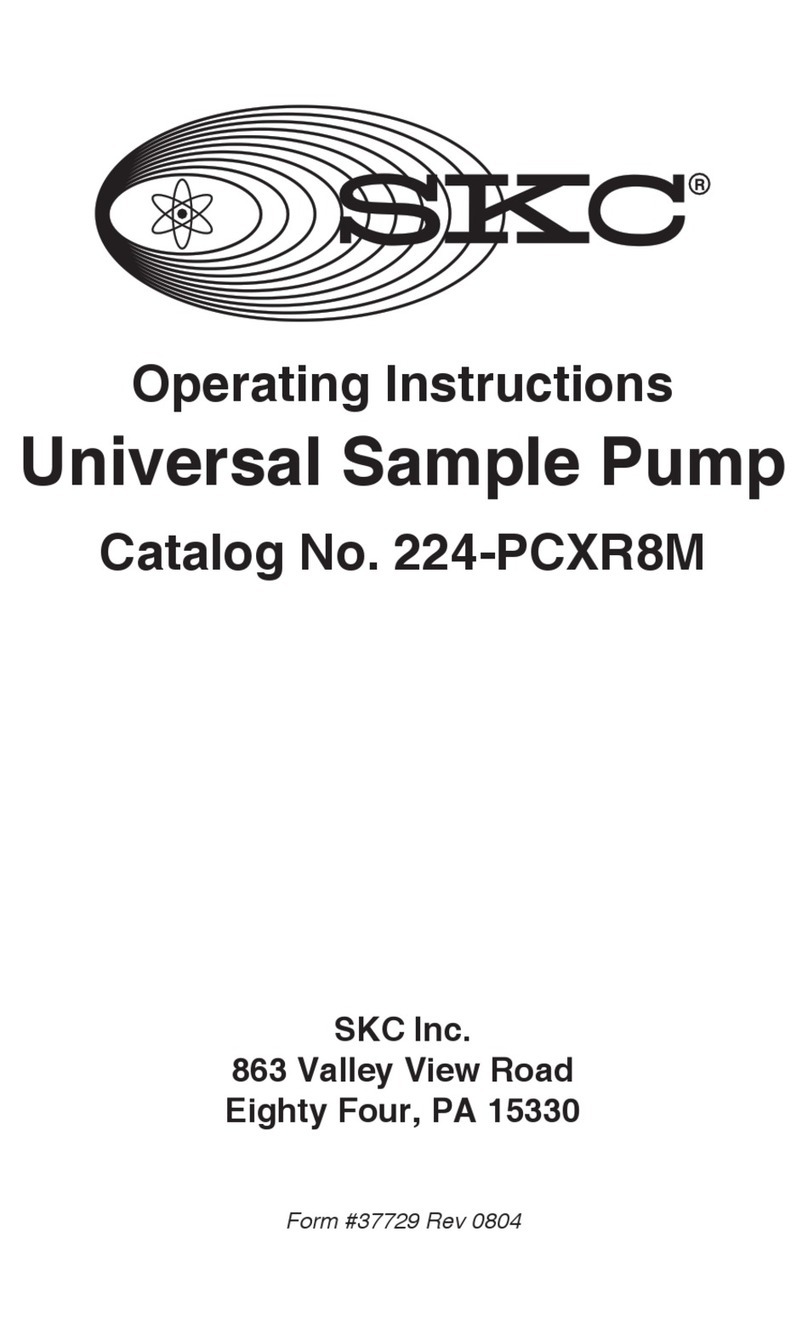
SKC
SKC 224-PCXR8M User manual

SKC
SKC 220 Series User manual
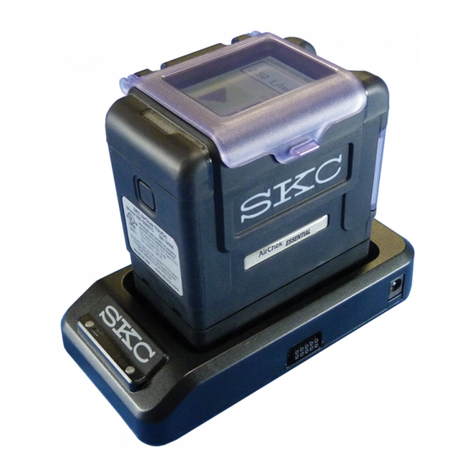
SKC
SKC AirChek ESSENTIAL User manual
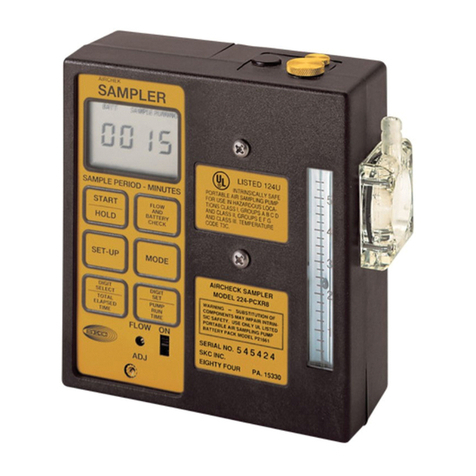
SKC
SKC 224-PCXR8 User manual
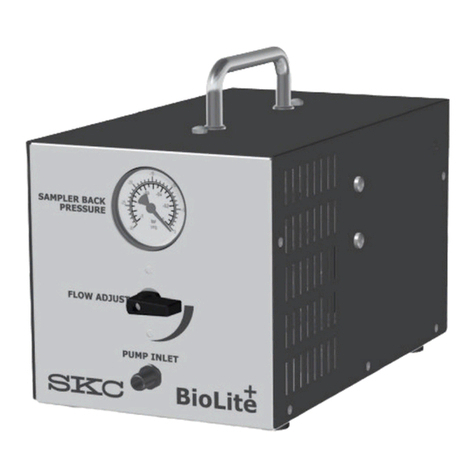
SKC
SKC BioLite Plus 228-9620 User manual

SKC
SKC Leland Legacy User manual

SKC
SKC 210-1002MTX User manual

SKC
SKC AirChek XR5000 User manual
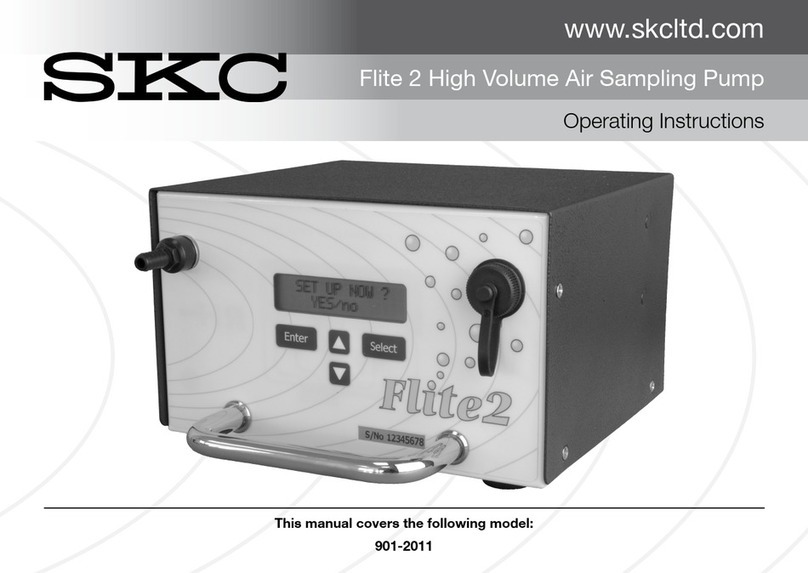
SKC
SKC Flite 2 User manual
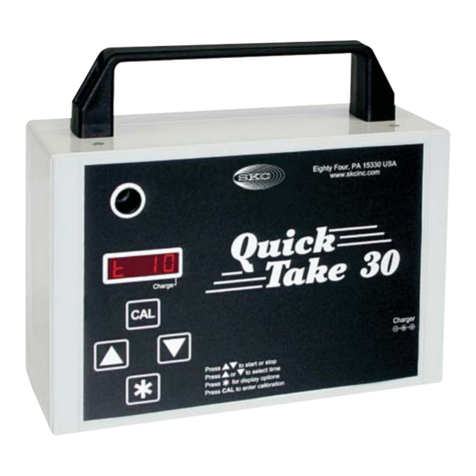
SKC
SKC QuickTake 30 User manual
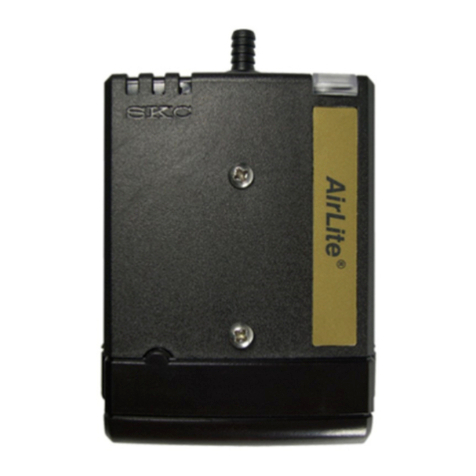
SKC
SKC AirLite 110-100-T User manual

SKC
SKC Vac-U-Go 228-9605 User manual
